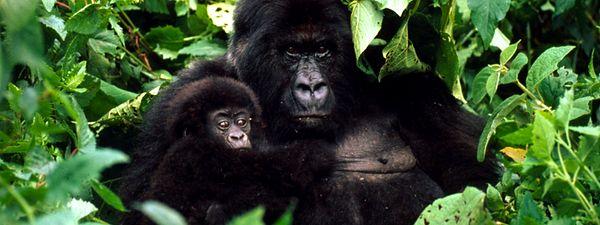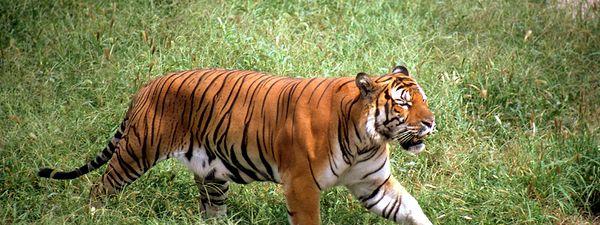 17 Animal Species On The Verge Of Extinction
17 Animal Species On The Verge Of Extinction
According to scientists, our planet is now in the midst of its sixth mass extinction of plants and animals — the sixth wave of extinctions in the past half-billion years. We’re currently experiencing the worst spate of species die-offs since the loss of the dinosaurs 65 million years ago. Although extinction is a natural phenomenon, it occurs at a natural “background” rate of about one to five species per year. Scientists estimate we’re now losing species at 1,000 to 10,000 times the background rate, with literally dozens going extinct every day. 30 to 50 percent of all species are possibly heading toward extinction by mid-century.
And unfortunately, our knowledge on biodiversity and ecosystems is scarce.
Karmenu Vella, European Commissioner for the Environment, gave a speech last year on Biodiversity, Food and Sustainable Development at Milan Expo Biodiversity Park and said “To quote the World Resources Institute, we know more on how many stars there are in our galaxy than how many species there are on Earth!”
So, now is the time for us to pay attention to what we’re about to lose if we keep dominating nature relentlessly.
1. Black Rhino

It was not uncommon for five or six rhinos to be killed in a day for food or simply for amusement. European settlers that arrived in Africa in the early 20th century to colonize and establish farms and plantations continued this senseless slaughter. Most people regarded rhinos as vermin and exterminated them at all costs.
Newspaper articles said just a few years ago that rhinos were “doomed to disappear from the face of the earth due to man’s folly, greed, neglect.” Ever since, a lot has been done to protect African rhinos, and now their population has reached more than 5,000 again. But still, their situation is regarded as 'endangered.'
2. Cross River Gorilla

Cross River gorillas live in a region populated by many humans who have encroached upon the gorilla’s territory—clearing forests for timber and to create fields for agriculture and livestock. Poaching occurs in the forests as well, and the loss of even a few of these gorillas has a detrimental effect on such a small population. Efforts to protect these animals are focused on securing the forests that house them.
There are about 200-300 Cross River gorillas left.
3. Hawksbill Turtle

Hawksbills are found mainly throughout the world's tropical oceans, predominantly in coral reefs. They feed mainly on sponges by using their narrow pointed beaks to extract them from crevices on the reef, but also eat sea anemones and jellyfish. Sea turtles are the living representatives of a group of reptiles that have existed on Earth and traveled our seas for the last 100 million years. They are a fundamental link in marine ecosystems and help maintain the health of coral reefs and sea grass beds.
Hawksbill Turtles are one of the species that are considered to be 'critically endangered.'
4. Amur leopard

People usually think of leopards in the savannas of Africa, but in the Russian Far East, a rare subspecies has adapted to life. Similar to other leopards, the Amur leopard can run at speeds of up to 37 miles per hour. The Amur leopard is solitary. Nimble-footed and strong, it carries and hides unfinished kills so that they are not taken by other predators.
The last remaining viable wild population is estimated to be a few more than 60 individuals.
5. Javan Rhino

Javan rhinos are the most threatened of the five rhino species, with 60 individuals surviving in Ujung Kulon National Park in Java, Indonesia. Vietnam’s last Javan rhino was poached in 2010. The Javan rhino is a dusky grey color and has a single horn of up to about 10 inches. Their skin has a number of loose folds giving the appearance of armor plating. This species is very similar in appearance to the closely-related greater-one rhinoceros, but has a much smaller head and less apparent skin folds.
6. Leatherback Turtle

Leatherback turtles are named for their shell, which is leather-like rather than hard, like other turtles. They are the largest sea turtle species and also one of the most migratory, crossing both the Atlantic and Pacific Oceans.
Globally, leatherback status according to IUCN is listed as Vulnerable, but many subpopulations (such as in the Pacific and Southwest Atlantic) are critically endangered.
7. Mountain Gorilla

As their name implies, mountain gorillas live in forests high in the mountains, at elevations of 8,000 to 13,000 feet. They have thicker fur, and more of it, compared to other great apes. The fur helps them to survive in a habitat where temperatures often drop below freezing. But as humans have moved more and more into the gorillas’ territory, the gorillas have been pushed farther up into the mountains for longer periods, forcing them to endure dangerous and sometimes deadly conditions.
Their population is estimated to be around 880 individuals.
8. Pangolin

These solitary and primarily nocturnal animals are easily recognized by their full armor of scales. Also called scaly anteaters because of their preferred diet, pangolins are increasingly victims of illegal wildlife crime—mainly in Asia and in growing amounts in Africa—for their meat and scales.
Eight species of pangolins are found on two continents. They range from Vulnerable to Critically Endangered.
9. Saola

Saolas are recognized by two parallel horns with sharp ends, which can reach 20 inches in length and are found on both males and females. Meaning “spindle horns” in Vietnamese, they are a cousin of cattle but resemble an antelope.
They are found only in the Annamite Mountains of Vietnam and Laos and their status is 'critically endangered.'
10. South China Tiger

The South China tiger population was estimated to number 4,000 individuals in the early 1950s. In the next few decades, thousands were killed as the subspecies was hunted as a pest. The Chinese government banned hunting in 1979. By 1996 the population was estimated to be just 30-80 individuals.
Today the South China tiger is considered by scientists to be “functionally extinct,” as it has not been sighted in the wild for more than 25 years.
11. Sumatran Elephant

Sumatran elephants feed on a variety of plants and deposit seeds wherever they go, contributing to a healthy forest ecosystem. They also share their lush forest habitat with several other endangered species, such as the Sumatran rhino, tiger, and orangutan, and countless other species, all benefiting from an elephant population that thrives in a healthy habitat.
12. Sumatran Orangutan

The Sumatran orangutan is almost exclusively arboreal, living among the trees of tropical rainforests. Females virtually never travel on the ground and adult males do so rarely.
Of the nine existing populations of Sumatran orangutans, only seven have prospects of long-term viability, each with an estimated 250 or more individuals. Only three populations contain more than 1,000 orangutans. Orangutans that were confiscated from the illegal trade or as pets are being reintroduced to Bukit Tigapuluh National Park. They number around 70 and are reproducing.
13. Sumatran Rhino

Sumatran rhinos are the smallest of the living rhinoceroses and the only Asian rhino with two horns. They are covered with long hair and are more closely related to the extinct woolly rhinos than any of the other rhino species alive today.
Two different subspecies, the western Sumatran and eastern Sumatran, cling for survival on the islands of Sumatra and Borneo. Experts believe the third subspecies is probably extinct.
14. Sumatran Tiger

Sumatran tigers are the smallest surviving tiger subspecies and are distinguished by heavy black stripes on their orange coats.
This tiger subspecies is found only on the Indonesian island of Sumatra. Fewer than 400 Sumatran tigers exist today. In 1978, experts estimated the population of Sumatran tigers to be 1,000.
15. Vaquita

Vaquita, the world’s most rare marine mammal, is on the edge of extinction. This little porpoise wasn't discovered until 1958 and a little over half a century later, we are on the brink of losing them forever. Vaquita are often caught and drowned in gillnets used by illegal fishing operations in marine protected areas within Mexico's Gulf of California. More than half of the population has been lost in the last three years.
16. Western Lowland Gorilla

The western lowland gorilla is the most numerous and widespread of all gorilla subspecies. Populations can be found in Cameroon, the Central African Republic, the Democratic Republic of Congo and Equatorial Guinea as well as in large areas in Gabon and the Republic of Congo. The exact number of western lowland gorillas is not known because they inhabit some of the most dense and remote rainforests in Africa. Significant populations still exist, including in isolated swamps and the remote swampy forests of the Republic of Congo.
17. Yangtze Finless Porpoise

The Yangtze River, the longest river in Asia, used to be one of the only two rivers in the world that was home to two different species of dolphin—the Yangtze finless porpoise and the Baiji dolphin. However, in 2006 the Baiji dolphin was declared functionally extinct. This was the first time in history that an entire species of dolphin had been wiped off the planet because of human activity.
Its close cousin, the Yangtze finless porpoise, is known for its mischievous smile and has a level of intelligence comparable to that of a gorilla.
Keşfet ile ziyaret ettiğin tüm kategorileri tek akışta gör!


Send Comment
comment fast
i have question